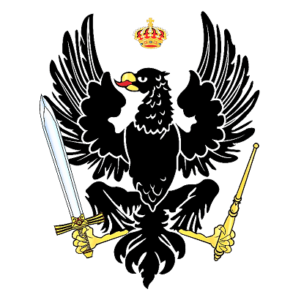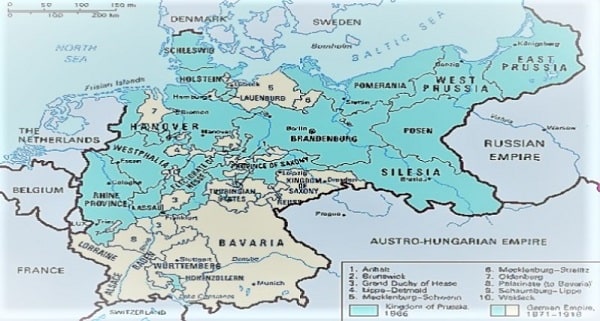The Kingdom of Prussia was a European state that existed from 1701 to 1918. Ruled throughout its existence by the Franconian branch of the Hohenzollern dynasty, it was originally centered in Brandenburg-Prussia. However, and mainly thanks to its military power, it managed to expand territorially.
At the end of the Austro-Prussian War, he had achieved total hegemony over northern Germany. In 1871, after the Franco-Prussian War, the German Empire was proclaimed, at which time Prussia reached its maximum territorial extension.
Although together with other Germanic kingdoms it became part of the new German state, it was by far the largest and most important, covering more than half of the Empire’s surface, some 348,780 km² in 1910.
As it had the largest economy and the largest army in Germany, Prussia guaranteed its political hegemony; the kings of Prussia were also German emperors. In 1918, when Germany was defeated in World War I, a socialist revolution overthrew the monarchy and the kingdom became the Free State of Prussia, a federated state within the new German Republic.

Facts About Kingdom Of Prussia
- Kingdom of Prussia: 1701 to 1918
- Capital: Berlin, Königsberg (In 1806)
- Common languages: German
- Religion Majority:
Protestantism (Lutheran and Reformed; since 1817 Prussian United)
• Minorities:
Roman Catholicism, Judaism - Population:
• In 1816: 10,349,031
• In 1871: 24,689,000
• In 1910: 40,169,219 - Area: In 1910: 348,779 km² (134,664 sq mi)
- Currency:
• 1701–1750: Reichsthaler
• 1750–1857: Thaler
• 1857–1873: Vereinsthaler
• 1873–1914: Goldmark
• 1914–1918: Papiermark - King:
• 1701–1713 (first): Frederick I
• 1888–1918 (last): Wilhelm II - Minister-President:
• 1848 (first): Adolf Heinrich
• 1918 (last): Max von Baden - Prussia Today part of:
• Czech Republic
Czech Republic
• Denmark
Denmark
• Germany
Germany
• Lithuania
Lithuania
• Poland
Poland
• Russia
Russia
• Belgium
Belgium
The History Of Prussia
In 1688, Frederick III became Prince-Elector of Brandenburg, and his ambition was to be crowned King of Prussia. He gets satisfaction in 1701, under the name of Frederick I st with the title “King” in “Prussia” (no one can be crowned king inside the Holy Roman Empire). But the Hohenzollerns dynasty quickly swept away this nuance and called themselves “kings of Prussia”.
From that time on, the term “Prussia” covers territories that are not part of the original Prussia. Under the reign of Frederick II, from 1740 to 1774, the kingdom became a great political and military power, considerably increasing its territory through the acquisition of Silesia (1742) and Royal Prussia (which then became the province of Prussia). -Western) in 1772.
At the end of the 17th century, the Prussian territory still expanding eastward at the second and third partitions of Poland in 1793 and 1795. The province created around Posen / Poznan (1793), then Warsaw (1795) receives the name of South Prussia.
During the Napoleonic Wars, the Kingdom of Prussia was one of the opponents of the French Empire. Defeated at Jena and Auerstaedt in 1806, almost wiped out, Prussia loses South Prussia (which becomes the Duchy of Warsaw).
However, after having actively participated in the fighting from 1813 to 1815 (German uprising of 1813, the campaign of France in 1814, the battle of Waterloo in 1815), the kingdom accumulated annexations during the Congress of Vienna, annexing Rhineland and Westphalia, thus forming a Prussian Rhineland (or Rhine Province).
The addition of these territories allows Prussia to considerably strengthen its economic weight, Rhenish Prussia being the first mining region in Germany. This kingdom quickly gained ascendancy over the northern states of the Germanic Confederation with which it formed a Zollverein (Customs Union) from 1834.
The war of the Duchies against Denmark allows King William I, at the instigation of his chancellor Otto von Bismarck, to control Schleswig in 1864. Then, after the Battle of Königgrätz (Or Sadowa) and the ouster from the Austrian Empire in 1866, Prussia took over the confederation of North Germany and occupied the Duchy of Holstein.
The war against France allows the kingdom and its German allies to perfect the German unity by founding in 1871 the German Empire (Reich, the first – the Holy Roman Empire – have been dissolved in 1806 by Francis II under pressure from Napoleon I, when the Emperor of the Holy Empire of Germany renounced the crown no longer emperor of Austria), in which the kingdom of Prussia holds a dominant share, as its ruler William I first became emperor.
We then designate by Prussia two provinces of the kingdom: that of West Prussia and that of East Prussia, which for a time formed only one province of Prussia.
The German defeat in 1918 at the end of the First World War and the revolutionary explosion in the large urban centers swept the Empire and the Hohenzollern dynasty. William II, grandson, and successor of William I abdicated in November 1918.
Prussia Kings
When in 1701 Frederick I obtained the royal title, his title was “King in Prussia” which imperatively submitted his sovereignty over the territory to the crown of the Holy Roman Empire. It was only with Frederick II that Prussia managed to obtain the recognized rank of Kingdom in all respects, even more so with the collapse of the Holy Roman Empire in 1806.
Even after the proclamation of the German Empire, Prussia remained an independent kingdom within Germany and continued to be ruled by the Hohenzollerns who in the meantime had ascended to the imperial throne, while maintaining their specific prerogative of King of Prussia.
- Frederick I: (11 July 1657 – 25 February 1713), (aged 55) – Son of Frederick William, also Elector of Brandenburg
- Frederick William I: (14 August 1688 – 31 May 1740), (aged 51) – Son of Frederick I
- Frederick II: (24 January 1712 – 17 August 1786), (aged 74) – Son of Frederick William I
- Frederick William II: (25 September 1744 – 16 November), (aged 53) – Nephew of Frederick II, Grandson of Frederick William I
- Frederick William III: (3 July 1770 – 7 June 1840), (aged 69) – Son of Frederick William II
- Frederick William IV: (15 October 1795 – 2 January 1861), (aged 65) – Son of Frederick William III; also President of the Erfurt Union (1849–1850)
- William I: (22 March 1797 – 9 March 1888), (aged 90) – Brother of Frederick William IV, Son of Frederick William III; also President of the North German Confederation (1867–1871) and German Emperor (from 1871)
- Frederick III: (18 October 1831 – 15 June 1888), (aged 56) – Son of William I; also German Emperor
- William II: (27 January 1859 – 4 June 1941), (aged 82) – Son of Frederick III; also German Emperor; also last King of Prussia and last German Emperor









